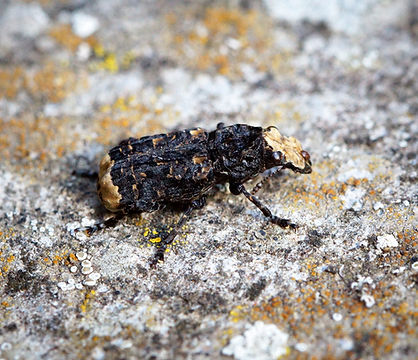.png)
A necessary weevil?
By Gary Easton, member of Devon Fungus Group and BMS Fungal Education and Outreach Committee
I’ve never seen the beetle known as the Scarce Fungus Weevil (Platyrhinus resinosus) in real life; I suppose the clue is in the name but I’ve seen photographs and heard about it. It’s between 7 and 15 mm in length - which is big for a weevil. The general appearance is grey, black and buff in patches, which is said to make it look like a bird dropping - a bit unkind, but useful camouflage. These adult weevils are found flying between spring and autumn, mainly in the months of June and July.
Lots of arthropods lay eggs in fungal fruiting bodies (mushrooms) particularly dipteran flies. Who hasn’t picked up a potentially tasty mushroom only to find it’s crawling with maggots!
However, as far as I know, this weevil is the only one to lay its eggs in Daldinia concentrica otherwise known as Cramp Balls or King Alfred’s Cakes.
This round black fungal fruiting body grows on Ash (Fraxinus excelsior) and is relatively common. It’s a saprophytic ascomycete fungus living on dead and rotting Ash wood.
When introducing learners to fungi on a foray it’s a classic fungus to find and, apart from the joke of asking people not to get the common names mixed up, one can cut it open to show the concentric rings where spores are formed - relating to the species name concentrica. I’ve never checked these fungi for holes where weevil eggs may have been laid and I’ve never found a larva in one.
Recently, however, I had a chat with my friend Emma Williams and she did find larvae inside one that she had cut open. She always checks for holes but had missed this one and was horrified to find that she had disturbed these rare insects. To her credit (and possibly beyond the call of duty) she took them home, and kept them growing on Daldinia and decaying Ash until - approximately 2 years later - they became adult and she returned them to their original site. Well done Emma! Now I also check for holes.
The relationship between Ash trees, Daldinia and Scarce Fungus Weevils reminded me of a phrase in Darwin’s Origin of Species - a quote about a tangled bank: “elaborately constructed forms so different from each other, and dependent upon each other in so complex a manner”. The rise in Ash Dieback fungus (Hymenoscyphus fraxineus) has led to a lot of felling of Ash trees (unnecessarily, in some cases) resulting in a lot of dead Ash wood, although a lot is used for firewood.
Will this lead to an increase in Daldinia and make the weevil less scarce? But what happens when the Ash trees are gone? Also I’m told that foragers collect old Daldinia fruiting bodies to use as firelighters, which may also affect weevil populations.
There appears to be some resistance to Ash Dieback in Ash trees so hopefully they’ll keep going, along with the fungus and the weevil. Keep a look out and appreciate them all.
P.S. Wikipedia informs me that caterpillars of the concealer moth Harpella forficella have also been found to eat Daldinia concentrica!
_(39984345353).jpg)